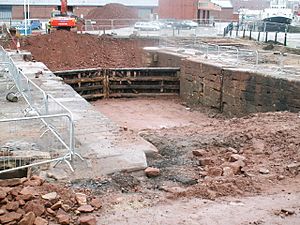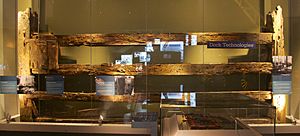Manchester Dock (Liverpool) facts for kids
Quick facts for kids Manchester Dock |
|
|---|---|

Manchester Dock entrance lock, unearthed during 2007 for the excavation for the Liverpool Canal Link.
|
|
| Location | |
| Location | Liverpool, United Kingdom |
| Coordinates | 53°24′11″N 2°59′42″W / 53.4031°N 2.9949°W |
| OS grid | SJ339900 |
| Details | |
| Opened | 1785 |
| Closed | 1929 |
| Type | Wet dock |
| Area | 1 acre (0.40 ha), 595 sq yd (497 m2) |
| Width at entrance | 32 ft 10 in (10.01 m) |
| Quay length | 339 yd (310 m) |
Manchester Dock was a busy dock in Liverpool, England. It was a key part of the Port of Liverpool and sat right on the River Mersey. Unlike some other docks, it wasn't connected to a big network of docks. Instead, it had its own direct link to the river.
The Story of Manchester Dock
Back in the 1780s, the docks in Liverpool were getting bigger. A special water area called Manchester Basin was built near Canning Dock. This basin was connected straight to the River Mersey and was affected by the tide. It wasn't linked to the other docks nearby.
People soon saw how useful it would be as a real dock. So, between 1810 and 1815, an engineer named John Foster, Sr. built a special gate, called a lock, to connect it. After that, it became known as Manchester Dock.
This dock was super important! It helped send out things like coal and factory-made goods. It also brought in corn and cotton from other places. Later, in 1845, a company called the Shropshire Union Railways and Canal Company used the dock for their barges. Then, the Great Western Railway also used it to move goods between the dock and their train station in Birkenhead.
Between 1825 and 1857, a group called the Docks Committee managed the Liverpool Docks. During this time, the total area of the docks grew a lot, from 82 acres to 192 acres. The length of the quays (the edges where ships tie up) reached 15 miles by 1857! Most of this growth came from building new docks. But they also bought Manchester Dock in 1851. In 1858, a new group, the Mersey Docks and Harbour Board, took over control of all the docks.
By the 1920s, fewer ships were using Manchester Dock. The dock and the nearby Chester Basin started to sink. This happened because of digging work for the Queensway Tunnel, which ran underneath the area. Both docks were filled in by 1936, using rocks and dirt from the tunnel's construction. Later, the area became a car park, which helped protect what was left of the old dock underneath the ground.
Uncovering the Dock's Secrets

In 2006 and 2007, archaeologists dug up the dock area. This was part of a big building project for the new Museum of Liverpool and a new link for the Leeds and Liverpool Canal to the Canning and Albert Docks.
These digs also uncovered the nearby Chester Basin. The work gave us important clues about the past, especially since the entrance lock is one of the oldest in the entire Liverpool Docks system. Most other locks from that time have either been destroyed or changed a lot over the years.
Images for kids
-
Manchester Dock entrance lock, unearthed during 2007 for the excavation for the Liverpool Canal Link.
-
The dock gate on display at the Museum of Liverpool.





